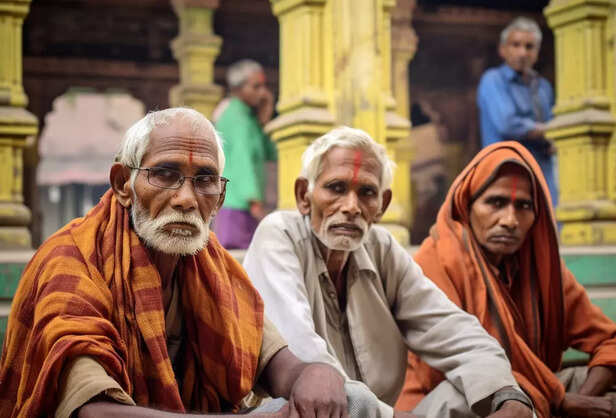Shocking Secrets of Mauni Amavasya: The Holy Dip That Can Change Your Destiny at Kumbh!
Tarun Badghaiya | Jan 29, 2025, 19:43 IST
The Maha Kumbh Mela, the world's largest religious gathering, is intricately connected to Hindu mythology and cosmic alignments. Mauni Amavasya is one of the most important days, with unequaled spiritual significance. Devotees believe that taking a holy bath in the Triveni Sangam on this day cleanses sins, brings divine benefits, and leads to moksha (freedom). This day is associated with Samudra Manthan, Sage Manu's penance, and Ganga's descent. It is a celestial time of self-purification, quiet, and enlightenment. As millions come together in devotion, Mauni Amavasya becomes the apex of faith, tradition, and the unending quest for salvation.
Maha Kumbh Mela is the world's largest religious gathering, celebrated once every 12 years in four sacred spots in India: Prayagraj (Allahabad), Haridwar, Ujjain, and Nashik. It is an ancient Hindu celebration steeped in mythology, spirituality, and astrological predictions. The event draws millions of pilgrims, saints, ascetics, and tourists from around the world, making it one of the most important cultural and religious gatherings in human history.

A. The Mythological Significance of Taking a
The practice of taking a sacred dip at the Kumbh Mela on Mauni Amavasya has ancient roots in Hindu mythology. It is linked to divine happenings, celestial alignments, and the search for moksha (freedom). Several legendary myths emphasize its importance.
1. The
The most major mythological connection is the story of Samudra Manthan (ocean churning), which appears in the Bhagavata Purana, Vishnu Purana, and Mahabharata.
Devas (gods) and Asuras (demons) churned the water, revealing a pot (Kumbh) of Amrit (nectar of immortality). A furious conflict erupted between the Devas and the Asuras for control of the Amrit. Lord Vishnu, in the shape of Mohini, brought the Kumbh across the sky.
During this journey, drips of Amrit fell in four locations: Prayagraj (Allahabad), Haridwar, Ujjain, and Nashik, where the Kumbh Mela is presently held. Mauni Amavasya is considered the most auspicious day to bathe in these hallowed waters since the divine energy of Amrit is thought to be at its peak on this day.
 According to Hindu mythology, Sage Manu, the progenitor of mankind, performed penance on Mauni Amavasya. It is believed that Lord Vishnu appeared before him and blessed him with divine wisdom. Devotees take a dip in the holy rivers on this day to seek knowledge, wisdom, and spiritual upliftment, following the path of Manu.
According to Hindu mythology, Sage Manu, the progenitor of mankind, performed penance on Mauni Amavasya. It is believed that Lord Vishnu appeared before him and blessed him with divine wisdom. Devotees take a dip in the holy rivers on this day to seek knowledge, wisdom, and spiritual upliftment, following the path of Manu.
According to legend, the Ganga River descended from the heavens to Earth as a result of King Bhagiratha's penance. The river is thought to contain divine purity and the ability to wash away sins. Bathing in the Ganga at Mauni Amavasya in Prayagraj is considered to be similar to taking a dip in all of India's sacred rivers.

According to Vedic astrology, on Mauni Amavasya, the Sun and Moon unite in Capricorn (Makara Rashi), resulting in an amazing spiritual energy field. This alignment is thought to increase the effectiveness of holy waters, making it the most effective day for purification. It is stated that bathing in the river on this day results in emancipation (moksha) and enormous spiritual merit.
The word "Mauni" is derived from "Mauna," which means silence. It is claimed that on this day, the great sages and rishis would sit in quiet and meditate, absorbing the holy energies of the universe. This custom is followed by devotees who remain silent, meditate, and take a holy dip in the hopes of achieving self-realization and inner serenity.
The holy dip on Mauni Amavasya during the Kumbh Mela is more than just ceremonial; it is a sacred act profoundly rooted in Hindu mythology. It is seen to be the finest time to wash away sins, gain insight, and progress towards liberation. The cosmic alignment, combined with the divine history of the Samudra Manthan, Sage Manu, and Ganga Avataran, renders it the most potent and spiritually charged day of the Kumbh Mela.
Taking a holy dip at the Kumbh Mela on Mauni Amavasya has profound spiritual and religious significance in Hinduism. It is regarded as the most auspicious day for bathing in sacred rivers, particularly the Ganga, Yamuna, and the mythical Saraswati at Prayagraj (Allahabad).

It is said that bathing in the sacred river on this day cleanses sins and aids in the attainment of moksha (freedom from the cycle of birth and death). The river is supposed to be filled with divine energy, and bathing connects the soul to the divine.
Mauni Amavasya is the most important bathing day of the Kumbh Mela, often known as the "Royal Bath" (Shahi Snan). Saints, sadhus, and millions of devotees flock to partake in this sacred event. Silence and Self-realization (Mauna Vrata)
"Mauni" is derived from the word "mauna," which means silence. Many followers take a vow of silence (Mauna Vrata) on this day to concentrate on self-discipline, meditation, and spiritual awakening. Silence is said to promote inner serenity and heavenly connection. Cosmic and astronomical importance
The planetary alignment on Mauni Amavasya is seen as particularly beneficial to spiritual practices. The Sun and Moon align in Capricorn (Makara Rashi), generating an energy field that amplifies the advantages of bathing in the sacred rivers.
Sage Manu, the first human in Hindu mythology, is said to have undertaken penance on this day. Devotees follow in his footsteps, practising austerity and seeking blessings for wisdom and enlightenment.
The Naga Sadhus and other ascetic groups take the ceremonial dip first, which signals the start of the bathing ceremonies. This is a rare and holy sight since these saints give up earthly pleasures to devote their lives to spiritual endeavours.

A holy dip on Mauni Amavasya during the Kumbh Mela is more than just a ritual; it is a spiritual journey of self-purification, devotion, and enlightenment. It is an opportunity for millions of believers to purify their spirits, seek divine graces, and witness a unique cosmic alignment of religion and tradition.
The Mahakumbh Mela is the world's greatest spiritual gathering, representing faith, dedication, and an unending pursuit for salvation. Among its numerous sacred bathing days, Mauni Amavasya is the most significant. This day is thought to be the most spiritually beneficial, as it is based on mythology, celestial alignments, and old customs.
The act of taking a holy plunge in the Triveni Sangam is said to cleanse sins, liberate the soul, and raise spiritual consciousness. As millions of devotees, saints, and seekers gather at the Mahakumbh, Mauni Amavasya provides a sublime moment of purification, silence, and self-realization, reinforcing the Kumbh Mela's timeless spiritual core.

Ganga
A. The Mythological Significance of Taking a Holy Dip at Kumbh during Mauni Amavasya :
1. The Samudra Manthan (Churning of the Ocean) and the Origin of Kumbh Mela:
Devas (gods) and Asuras (demons) churned the water, revealing a pot (Kumbh) of Amrit (nectar of immortality). A furious conflict erupted between the Devas and the Asuras for control of the Amrit. Lord Vishnu, in the shape of Mohini, brought the Kumbh across the sky.
During this journey, drips of Amrit fell in four locations: Prayagraj (Allahabad), Haridwar, Ujjain, and Nashik, where the Kumbh Mela is presently held. Mauni Amavasya is considered the most auspicious day to bathe in these hallowed waters since the divine energy of Amrit is thought to be at its peak on this day.

Samudra manthan
2. Connection to Sage Manu and the Creation of Mankind:
3. The Descent of Ganga (Ganga Avataran):

ganga river
4. Celestial Alignment and the Power of Mauni Amavasya:
5. The Ritual of Silence (Mauna Vrata) and Its Divine Connection:
The holy dip on Mauni Amavasya during the Kumbh Mela is more than just ceremonial; it is a sacred act profoundly rooted in Hindu mythology. It is seen to be the finest time to wash away sins, gain insight, and progress towards liberation. The cosmic alignment, combined with the divine history of the Samudra Manthan, Sage Manu, and Ganga Avataran, renders it the most potent and spiritually charged day of the Kumbh Mela.
Taking a holy dip at the Kumbh Mela on Mauni Amavasya has profound spiritual and religious significance in Hinduism. It is regarded as the most auspicious day for bathing in sacred rivers, particularly the Ganga, Yamuna, and the mythical Saraswati at Prayagraj (Allahabad).

sadhus at prayag
B. The Significance of Mauni Amavasya at Kumbh Mela:
1. Spiritual Purification & Moksha:
2. Most Auspicious Day of Kumbh Mela:
"Mauni" is derived from the word "mauna," which means silence. Many followers take a vow of silence (Mauna Vrata) on this day to concentrate on self-discipline, meditation, and spiritual awakening. Silence is said to promote inner serenity and heavenly connection. Cosmic and astronomical importance
The planetary alignment on Mauni Amavasya is seen as particularly beneficial to spiritual practices. The Sun and Moon align in Capricorn (Makara Rashi), generating an energy field that amplifies the advantages of bathing in the sacred rivers.
3. Tradition of Sage Manu:
4. Sacred Gathering of Saints & Akharas:

sadhus
A holy dip on Mauni Amavasya during the Kumbh Mela is more than just a ritual; it is a spiritual journey of self-purification, devotion, and enlightenment. It is an opportunity for millions of believers to purify their spirits, seek divine graces, and witness a unique cosmic alignment of religion and tradition.
The Mahakumbh Mela is the world's greatest spiritual gathering, representing faith, dedication, and an unending pursuit for salvation. Among its numerous sacred bathing days, Mauni Amavasya is the most significant. This day is thought to be the most spiritually beneficial, as it is based on mythology, celestial alignments, and old customs.
The act of taking a holy plunge in the Triveni Sangam is said to cleanse sins, liberate the soul, and raise spiritual consciousness. As millions of devotees, saints, and seekers gather at the Mahakumbh, Mauni Amavasya provides a sublime moment of purification, silence, and self-realization, reinforcing the Kumbh Mela's timeless spiritual core.
